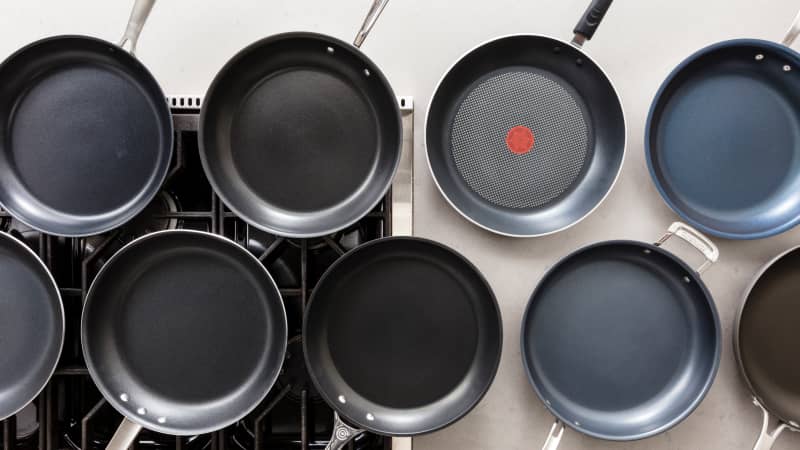The Best 12-Inch Carbon-Steel Skillets
Equipment Review
These pans are wildly popular for a reason. When you have a good one, food never sticks and cleanup is a breeze.
Last Updated Oct. 3, 2023. Appears in Cook's Country TV Season 14: Regional Sandwich Roundup

Our longtime favorite nonstick skillet is the OXO Good Grips Non-Stick Pro 12" Open Frypan. It’s lightweight yet sturdy and its surface remains reliably nonstick even after repeated use. Our favorite induction-compatible model is the All-Clad Stainless 12" Nonstick Fry Pan. It performs just as well as our winner but is more expensive and a bit less comfortable to maneuver. For an induction-compatible model that’s less than $50, we recommend the T-Fal Professional Non-Stick Fry Pan.
We’ve also tested smaller nonstick skillets and have similar recommendations. We especially like the 10-inch and 8-inch versions of the OXO nonstick skillet. For smaller induction-compatible models, look for the All-Clad skillet in 10-inch and 8-inch sizes. Finally, for less expensive induction-compatible skillets, try the 10-inch and 8-inch versions of the T-Fal.
What You Need to Know
Nonstick skillets have coatings on their cooking surfaces that prevent food from sticking. On the best ones, those coatings are impressively slick and relatively durable. You can crack an egg into one and count on a perfect fried egg sliding out a few minutes later. Sautéed vegetables move around the pan with ease and don’t stick or leave behind cooked-on bits that can burn. We often use them when making recipes with sugary sauces, including some stir-fries, that scorch easily. A nonstick skillet works well for cooking all sorts of other delicate and fast-cooking foods, from omelets and pancakes to pan-seared salmon and quesadillas. Another selling point is price. On average, they cost less than many stainless-steel, carbon-steel, and cast-iron pans.
We don’t recommend using nonstick skillets to make pan sauces. The surface is so slippery that it’s impossible to develop the stuck-on crispy bits of food (or fond) that are essential for adding deep, rich flavor to your sauce. They’re also not well suited for browning butter because their dark surfaces make it hard to see how much the butter has darkened.
Traditional nonstick skillets have coatings made with PTFE. Best known by the brand name Teflon, PTFE (polytetrafluoroethylene) belongs to a larger category of chemical compounds called PFAS, which are responsible for making surfaces slippery and resistant to water and oils. The way PTFE is produced has changed over the decades, making nonstick pans safer and more durable. Still, all PTFE coatings will eventually wear out with use, and previous tests have shown us that they scratch easily as well. We have tips for extending the life of your pan (see the FAQ “How can I make my nonstick skillet last longer?”), but you will need to replace your non...

The mission of America’s Test Kitchen Reviews is to find the best equipment and ingredients for the home cook through rigorous, hands-on testing. We stand behind our winners so much that we even put our seal of approval on them.

Kate is a deputy editor for ATK Reviews. She's a culinary school graduate and former line cook and cheesemonger.

Valerie is an associate editor for ATK Reviews. In addition to cooking, she loves skiing, traveling, and spending time outdoors.

Sarah is an assistant editor for ATK Reviews who is deeply passionate about anchovies and sourdough bread.

Hannah is an executive editor for ATK Reviews and cohost of Gear Heads on YouTube.

This is a members' feature.